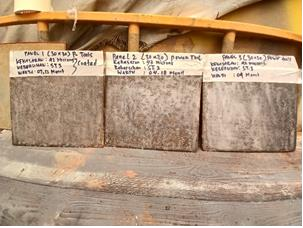Analysis of Power Tool Process on Surface Roughness Values in Confined Spaces
DOI:
https://doi.org/10.30649/baitaengineering.v2i2.55Keywords:
Offshore structures, surface preparation, power toolingAbstract
Corrosion is one of the main causes of damage to metal structures, particularly in the shipbuilding industry. It reduces material quality and service life, and can pose significant safety risks. To control corrosion, protective coating must be applied, and its effectiveness is highly dependent on the quality of surface preparation. Power tooling is a commonly used surface preparation method to remove contaminants such as rust, oil, and dirt that may affect coating adhesion. This method offers advantages such as ease of use, relatively low cost, and the ability to access confined spaces. This study aims to analyze the effect of using power tools to achieve a surface cleanliness level of St 3 (according to ISO 8501-1) on surface roughness and working time for steel specimens measuring 300 mm × 300 mm × 5 mm. A case study was also conducted on both flat and confined space surfaces to simulate real-world conditions commonly encountered onboard ships. Parameters measured include surface roughness values using standard instruments and duration of work in each area. The power tool test on flat surfaces produced an average surface roughness of 42.3 µm with a working time of 5 minutes and 10 seconds. In confined space areas, four tests were conducted: Area 1 yielded 48.5 µm roughness with 9 minutes 7 seconds working time; Area 2 yielded 36.5 µm with 11 minutes 35 seconds; Area 3 yielded 34.5 µm with 9 minutes 24 seconds; and Area 4 yielded 48.5 µm with 10 minutes 21 seconds.
Downloads
References
Agarwala, N. (2014). Surface Preparation for Repaired Structures of Ships. Proceedings of the Conference on Ship Maintenance and Repair, Cochin University of Science and Technology.
Ahmad, Z. (2006). Principles of Corrosion Engineering and Corrosion Control. Butterworth-Heinemann.
ASTM D4417 – method C. Standard Test Methods for Field Measurement of Surface Profile of Blast Cleaned Steel. America: The United States of America Legally Binding Document.
Azis, Moch Farid (2017) Analisa Pengaruh Material Abrasif pada Proses Blasting Terhadap Kualitas Coating Epoxy. Undergraduate thesis, Institut Teknologi Sepuluh Nopember.
Germanischer Lloyd. (2010). Rules for classification and construction: VI additional rules and guidelines. Germanischer Lloyd AG.
Hudson, R. (1982). Surface Preparation for Coating. The National Physical Labotary
ISO 8501-1:2007(en). Preparation of steel substrates before application of paints and related products — Visual assessment of surface cleanliness — Part 1: Rust grades and preparation grades of uncoated steel substrates and of steel substrates after overall removal of previous coatings.
Kaesche, H. (2003). Corrosion of Metals. New York: Springer Verlag Berlin Heidelberg.
K.M.Nova Satria, & Misbah Nurul. M. (2012). Analisis Pengaruh Salinitas dan Suhu Air LautTerhadap Laju Korosi Baja A36 padaPengelasan SMAW. Jurnal Teknik Its, 1, 2301–9271.
Fontana, M. G. (1986). Corrosion Engineering (3rd ed.). New York: McGraw-Hill.
Frenzel, L. M. (2012). A comparison of ISO and NACE-SSPC development of surface preparation standards including dry blast and high pressure water jet cleaning methods. Prepared for Pipelines Rehabilitation, Berlin, Germany.
Manurung, S. F. (2017). Analisa Pengaruh Proses Blasting Terhadap Kekuatan Adhesive Pada Coating Sambungan Pipa. Surabaya: Insttitut Teknologi Sepuluh Nopember.
Nabila, Nur Afni Wirda (2023) Analisa Pengaruh Variasi Waktu Sand Blasting Terhadap Kekasaran Permukaan Dan Variasi Coating Dengan Campuran Epoxy Serbuk Aluminium Terhadap Laju Korosi. Other thesis, Institut Teknologi Sepuluh Nopember.
Prahastu, S., & Triwilaswandio, W. P. (2012). Penerapan Peraturan IMO MSC.215(82) dan IMO MSC.291(87) PSPC pada Pembangunan Kapal Tanker Minyak. Jurnal Teknik Perkapalan, Jurusan Teknik Perkapalan, Fakultas Teknologi Kelautan, Institut Teknologi Sepuluh Nopember, Surabaya.
Santoso, I., Agila, D., Riasuti, R., & Tresna, R. (2024). Analysis of the Effect of Different Surface Preparation Methods on Corrosion Resistance and Adhesion Strength of ASTM A36 Steel Substrate with Surface Tolerant Epoxy Paint as Coating Material. Journal of Materials Exploration and Findings.
SSPC: The Society for Protective Coatings. (2002). SSPC-VIS 1 - Guide and Reference Photographs for Steel Surfaces Prepared by Dry Abrasive Blast Cleaning. The Society for Protective Coatings
SSPC. (2015). SSPC-SP 3: Power Tool Cleaning. Pittsburgh, PA: The Society for Protective Coatings.
SSPC. (2012). SSPC-SP 10: Near-White Metal Blast Cleaning. Pittsburgh, PA: The Society for Protective Coatings.
Supomo, Heri. (2003). Buku Ajar Korosi, Teknik Perkapalan FTK – ITS, Surabaya.
Vayas, I., et al. (2019). Design of Steel Structures to Eurocodes. Springer Nature Switzerland AG.

Published
How to Cite
Issue
Section
License
Copyright (c) 2025 BAITA Engineering: Journal of Naval Architecture and Marine Engineering

This work is licensed under a Creative Commons Attribution-NonCommercial 4.0 International License.




